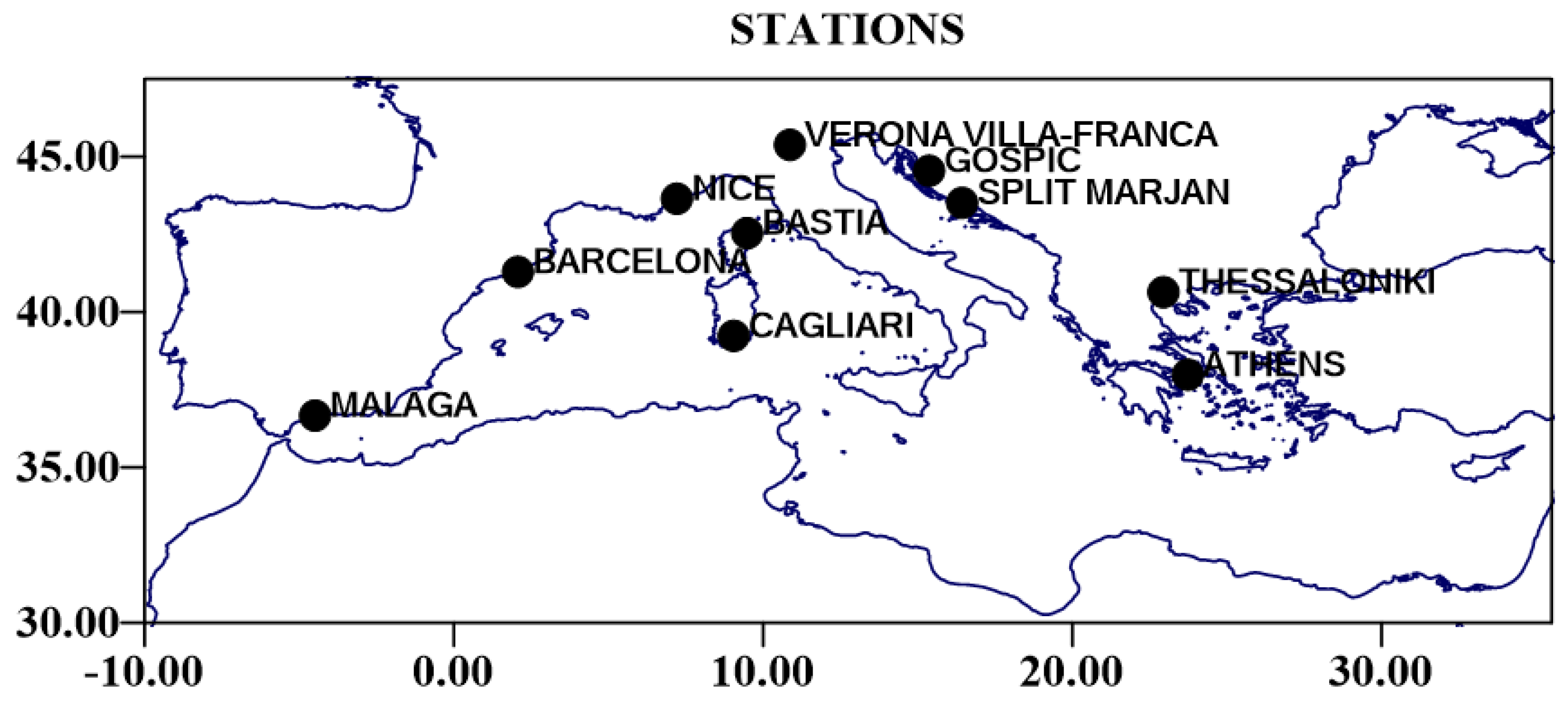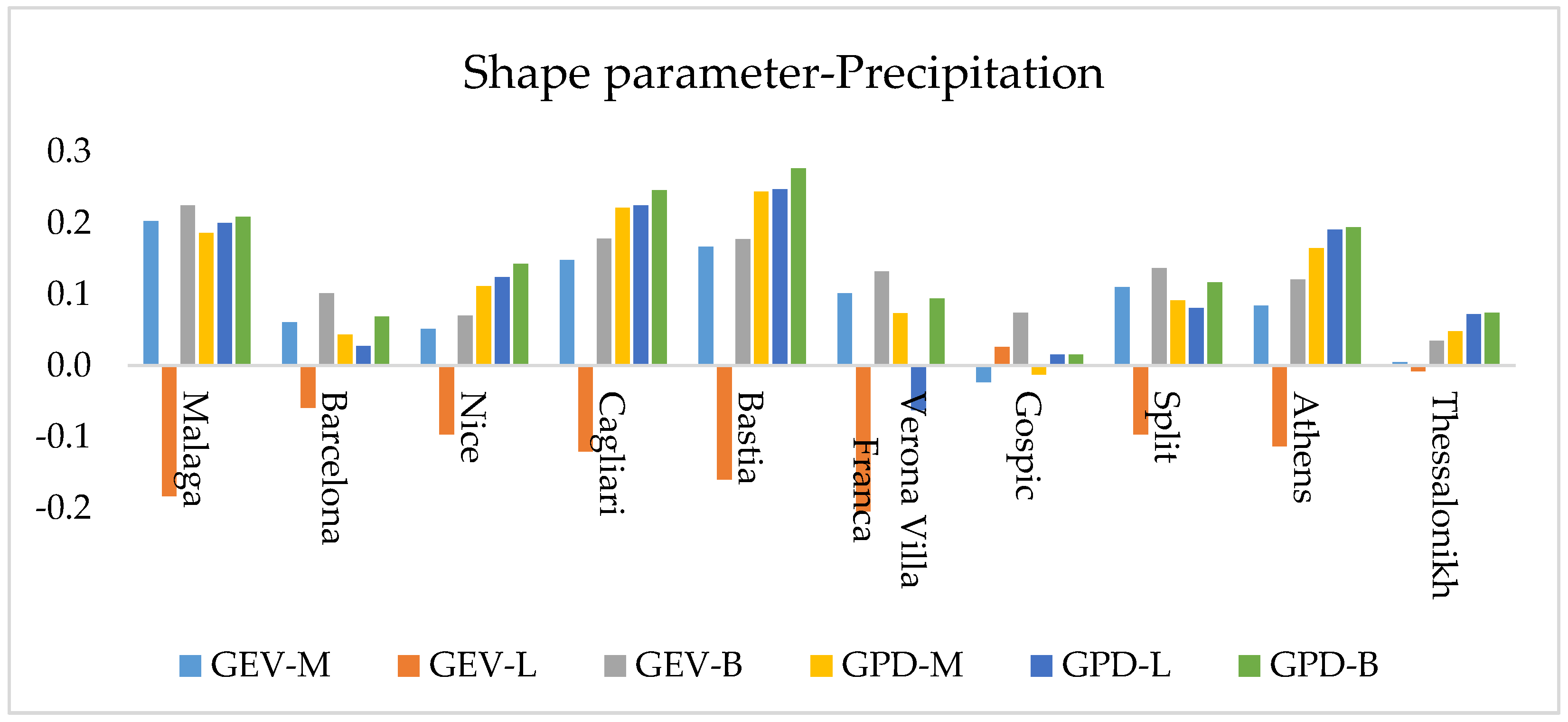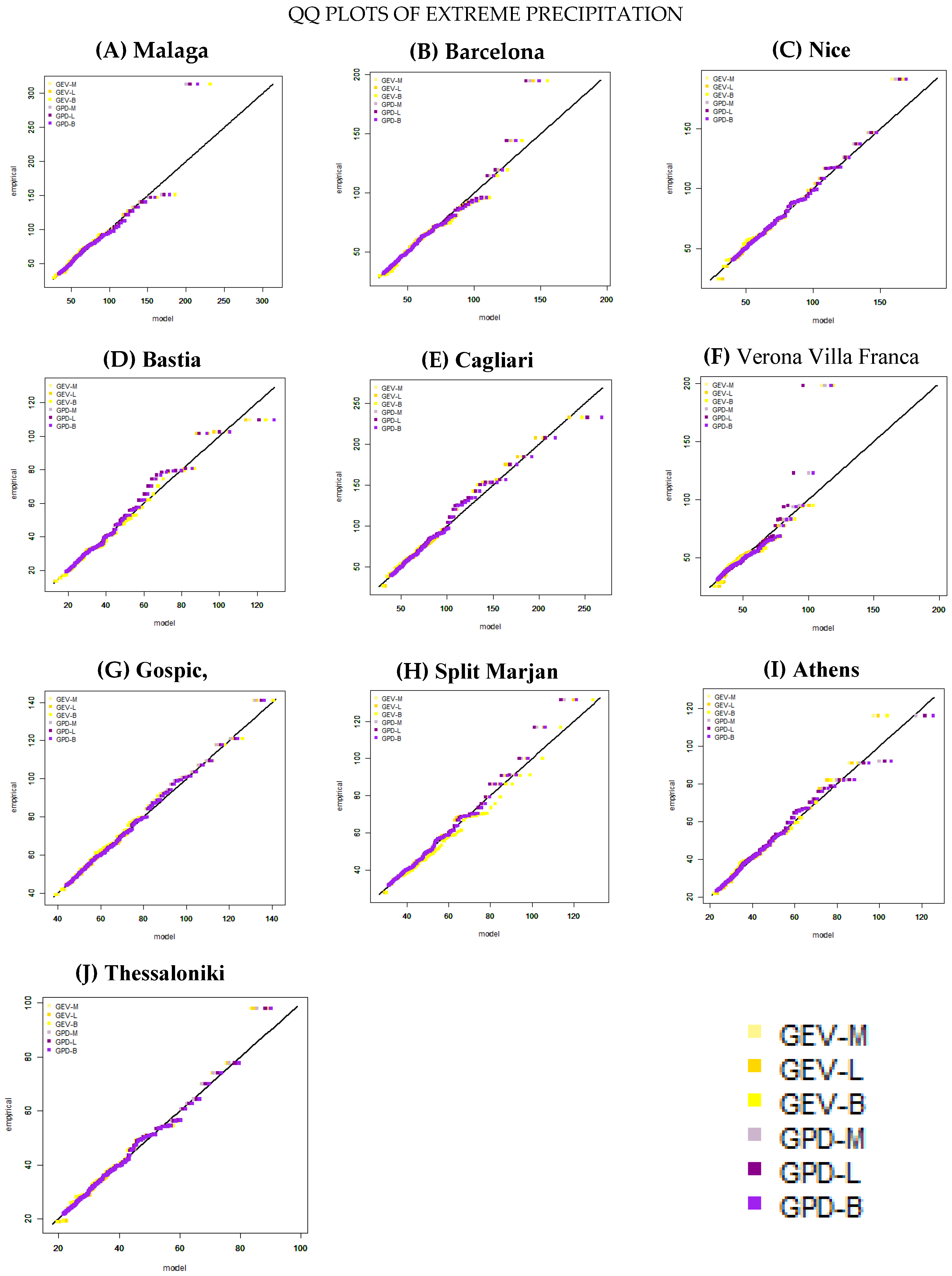An Overview of Statistical Methods for Studying the Extreme Rainfalls in Mediterranean †
Abstract
:1. Introduction
2. Experiments
2.1. Data
2.2. Methodology
3. Results
3.1. Climatology of the 10 Mediterannean Stations
3.2. Goodness of Fit Test with Shape Diagram
3.3. QQ-Plots
3.4. Return Levels
4. Discussion and Conclusions
Author Contributions
Conflicts of Interest
Abbreviations
| GEV-M | Generalized Extreme Value Distribution with the Maximum Liklihood estimation method |
| GEV-L | Generalized Extreme Value Distribution with the L-moments estimation method |
| GEV-B | Generalized Extreme Value Distribution with the Bayesian estimation method |
| GPD-M | Generalized Pareto Distribution with the Maximum Liklihood estimation method |
| GPD-L | Generalized Pareto Distribution with the L-moments estimation method |
| GPD-B | Generalized Pareto Distribution with the Bayesian estimation method |
| GEV-L | Generalized Extreme Value Distribution with the L-moments estimation method |
| MLE | Maximum Liklihood Estimation method |
| EVT | Extreme Value Theory |
| GEV | Generalized Extreme Value Distribution |
| GPD | Generalized Pareto Distribution |
| POT | Peaks Over Threshold |
References
- Pachauri, R.K.; Allen, M.R.; Barros, V.R.; Broome, J.; Cramer, W.; Christ, R.; Dubash, N.K. Climate Change 2014: Synthesis Report; Contribution of Working Groups I, II and III to the Fifth Assessment Report of the Intergovernmental Panel on Climate Change (IPCC): Geneva, Switzerland, 2014. [Google Scholar]
- Kyselý, J. Trends in heavy precipitation in the Czech Republic over 1961–2005. Int. J. Climatol. 2009, 29, 1745–1758. [Google Scholar] [CrossRef]
- Brunetti, M.; Maugeri, M.; Nanni, T. Changes in total precipitation, rainy days and extreme events in northeastern Italy. Int. J. Climatol. 2001, 21, 861–871. [Google Scholar] [CrossRef]
- Hundecha, Y.; Bardossy, A. Trends in daily precipitation and temperature extremes across western Germany in the second half of the 20th century. Int. J. Climatol. 2005, 25, 1189–1202. [Google Scholar] [CrossRef]
- Pal, J.; Giorgi, F.; Bi, X. Consistency of recent European summer precipitation trends and extremes with future regional climate projections. Geophys. Res. Lett. 2004, 31, 4. [Google Scholar] [CrossRef]
- Kharin, V.V.; Zwiers, F.W. Changes in the extremes in an ensemble of transient climate simulations with a coupled atmosphere-ocean GCM. J. Clim. 2000, 13, 3760–3788. [Google Scholar] [CrossRef]
- Katz, R.W.; Parlange, M.B.; Naveau, P. Statistics of extremes in hydrology. Adv. Water Resour. 2002, 25, 1287–1304. [Google Scholar] [CrossRef]
- García, J.A.; Serrano, A.; Gallego, M.C. A spectral analysis of Iberian Peninsula monthly rainfall. Theor. Appl. Climatol. 2002, 71, 77–95. [Google Scholar] [CrossRef]
- Coles, S. An Introduction to Statistical Modeling of Extreme Values; Springer Series in Statistics: London, UK, 2001. [Google Scholar]
- Beguería, S. Uncertainties in partial duration series modelling of extremes related to the choice of the threshold value. J. Hydrol. 2005, 303, 215–2309. [Google Scholar] [CrossRef]
- Hosking, J.R.M.; Wallis, J.R. Regional Frequency Analysis: An Approach Based on LMoments; Cambridge University Press: New York, NY, USA, 1997. [Google Scholar]
- Coles, S.; Dixon, M.J. Likelihood-based inference for extreme value models. Extremes 1999, 2, 5–23. [Google Scholar] [CrossRef]
- Klein Tank, A.M.G.; Wijngaard, J.B.; Können, G.P.; Böhm, R.; Demarée, G.; Gocheva, A.; Mileta, M.; Pashiardis, S.; Hejkrlik, L.; Kern-Hansen, C.; et al. Daily dataset of 20th century surface air temperature and precipitation series for the European Climate Assessment. Int. J. Climatol. 2002, 22, 1441–1453. [Google Scholar] [CrossRef]
- Anagnostopoulou, C.; Tolika, K. Extreme precipitation in Europe: Statistical threshold selection based on climatological criteria. Theor. Appl. Climatol. 2012, 107, 479–489. [Google Scholar] [CrossRef]
- Kyselý, J. Coverage probability of bootstrap confidence intervals in heavy-tailed frequency models, with application to precipitation data. Theor. Appl. Climatol. 2010, 101, 345–361. [Google Scholar] [CrossRef]
- Dyrrdal, A.V.; Lenkoski, A.; Thorarinsdottir, T.L.; Stordal, F. Bayesian hierarchical modeling of extreme hourly precipitation in Norway. Environmetrics 2015, 26, 89–106. [Google Scholar] [CrossRef]
- Roth, M.; Buishand, T.A.; Jongbloed, G.; Klein Tank, A.M.G.; van Zanten, J.H. Projections of precipitation extremes based on a regional, non-stationary peaks-over-threshold approach: A case study for the Netherlands and north-western Germany. Weather Clim. Extremes 2014, 4, 1–10. [Google Scholar] [CrossRef]
- El Adlouni, S.; Ouarda, T.B.M.J.; Zhang, X.; Roy, R.; Bobée, B. Generalized maximum likelihood estimators for the nonstationary generalized extreme value model. Water Resources Res. 2007, 43, 455–456. [Google Scholar] [CrossRef]
- Lee, S.H.; Maeng, S.J. Frequency analysis of extreme rainfall using L-moment. Irrig. Drain. 2003, 52, 219–230. [Google Scholar] [CrossRef]
- Trigo, I.; Davies, T.; Bigg, G. Objective climatology of cyclones in the Mediterranean region. J. Clim. 1999, 12, 1685–1696. [Google Scholar] [CrossRef]
- Maheras, P.; Flocas, A.H.; Patrikas, I.; Anagnostopoulou, C. A 40 year objective climatology of surface cyclones in the Mediterranean region: Spatial and temporal distribution. Int. J. Climatol. 2001, 21, 109–130. [Google Scholar] [CrossRef]
- Cooley, D.; Nychka, D.; Naveau, P. Bayesian Spatial Modeling of Extreme Precipitation Return Levels. J. Am. Stat. Assoc. 2007, 102, 824–840. [Google Scholar] [CrossRef]



| STATIONS | PRECIPITATION | ||
|---|---|---|---|
| Name | Country | Mean Daily (mm) | Absolute Maximum (mm) |
| Malaga | Spain | 1.55 | 313.00 |
| Barcelona | Spain | 1.72 | 194.80 |
| Nice | France | 2.20 | 191.40 |
| Bastia | France | 2.12 | 232.40 |
| Cagliari | Italy | 1.14 | 109.60 |
| Verona Villa Franca | Italy | 2.17 | 198.00 |
| Gospic | Croatia | 3.79 | 141.00 |
| Split Marjan | Croatia | 2.23 | 131.60 |
| Athens | Greece | 1.09 | 116.00 |
| Thessaloniki | Greece | 1.24 | 98.00 |
| Malaga | Barcelona | Nice | Cagliari | Bastia | Verona Villa Franca | Gospic | Split Marjan | Athens | Thessaloniki | |
| 50 YEARS | ||||||||||
| GEV-M | 194.9 | 140.1 | 153.6 | 110.8 | 222.2 | 106.4 | 128.3 | 115.9 | 93.9 | 81.2 |
| GEV-L | 192.9 | 139.7 | 158.7 | 109.0 | 221.8 | 113.1 | 129.7 | 115.7 | 95.8 | 81.9 |
| GEV-B | 216.4 | 150.4 | 162.6 | 117.3 | 231.8 | 111.9 | 134.5 | 122.9 | 99.3 | 85.5 |
| GPD-M | 191.6 | 138.0 | 156.0 | 115.1 | 240.1 | 109.3 | 129.0 | 111.9 | 112.4 | 83.0 |
| GPD-L | 195.7 | 135.3 | 158.6 | 115.1 | 239.3 | 94.1 | 131.9 | 110.4 | 116.2 | 85.6 |
| GPD-B | 203.2 | 143.8 | 163.9 | 120.7 | 255.7 | 113.1 | 132.4 | 116.3 | 117.9 | 86.7 |
| 150 YEARS | ||||||||||
| GEV-M | 258.0 | 167.9 | 183.4 | 142.4 | 287.1 | 128.4 | 145.3 | 140.9 | 113.0 | 94.0 |
| GEV-L | 252.4 | 167.3 | 194.0 | 137.9 | 285.6 | 146.0 | 146.9 | 139.8 | 117.1 | 95.0 |
| GEV-B | 297.7 | 185.2 | 195.6 | 150.4 | 309.3 | 138.8 | 155.5 | 154.2 | 122.3 | 102.8 |
| GPD-M | 248.9 | 163.6 | 190.3 | 153.7 | 325.7 | 130.2 | 147.0 | 134.4 | 143.2 | 98.1 |
| GPD-L | 256.8 | 159.0 | 194.9 | 154.1 | 325.4 | 105.1 | 151.3 | 131.8 | 150.7 | 102.4 |
| GPD-B | 270.0 | 172.8 | 203.6 | 163.9 | 354.8 | 136.3 | 152.0 | 141.6 | 152.7 | 104.1 |
| 300 YEARS | ||||||||||
| GEV-M | 305.5 | 186.4 | 203.1 | 165.0 | 334.4 | 143.6 | 155.7 | 158.2 | 126.0 | 102.1 |
| GEV-L | 296.4 | 185.5 | 218.2 | 158.1 | 331.8 | 171.3 | 157.5 | 156.4 | 131.9 | 103.3 |
| GEV-B | 361.6 | 209.2 | 217.5 | 174.0 | 368.0 | 158.0 | 168.9 | 176.8 | 138.4 | 114.3 |
| GPD-M | 291.6 | 180.3 | 214.1 | 183.4 | 392.8 | 144.2 | 158.3 | 149.8 | 165.6 | 108.0 |
| GPD-L | 302.9 | 174.4 | 220.5 | 184.1 | 393.1 | 111.6 | 163.8 | 146.4 | 176.4 | 113.8 |
| GPD-B | 321.0 | 192.3 | 232.0 | 197.7 | 434.3 | 152.1 | 164.5 | 159.3 | 178.6 | 115.8 |
Publisher’s Note: MDPI stays neutral with regard to jurisdictional claims in published maps and institutional affiliations. |
© 2017 by the authors. Licensee MDPI, Basel, Switzerland. This article is an open access article distributed under the terms and conditions of the Creative Commons Attribution (CC BY) license (https://creativecommons.org/licenses/by/4.0/).
Share and Cite
Lazoglou, G.; Anagnostopoulou, C. An Overview of Statistical Methods for Studying the Extreme Rainfalls in Mediterranean. Proceedings 2017, 1, 681. https://doi.org/10.3390/ecas2017-04132
Lazoglou G, Anagnostopoulou C. An Overview of Statistical Methods for Studying the Extreme Rainfalls in Mediterranean. Proceedings. 2017; 1(5):681. https://doi.org/10.3390/ecas2017-04132
Chicago/Turabian StyleLazoglou, Georgia, and Christina Anagnostopoulou. 2017. "An Overview of Statistical Methods for Studying the Extreme Rainfalls in Mediterranean" Proceedings 1, no. 5: 681. https://doi.org/10.3390/ecas2017-04132






